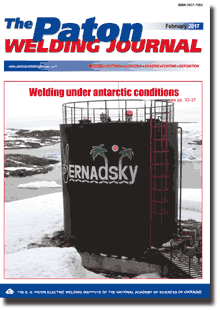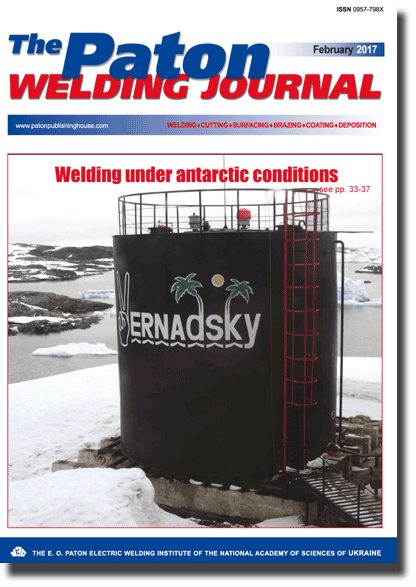Access for download PDF files for subscribers and for reviewers of scientometric bases.
Organization: Elsevier for content access(PDF files of journals released before 2024 are available for download from the website's archives))
Organization: Elsevier for content access(PDF files of journals released before 2024 are available for download from the website's archives))
| 2017 №02 (07) |
DOI of Article 10.15407/tpwj2017.02.08 |
2017 №02 (09) |

The Paton Welding Journal, 2017, #2, 38-44 pages
Effect of vibrotreatment on fatigue resistance and damping capacity of structural elements with residual stresses
V.A. Degtyarev
G.S. Pisarenko Institute for Problems of Strength, NASU 2 Timiryazevskaya Str., , 01014, Kiev, Ukraine. E-mail: ips@ipp.kiev.ua
Abstract
A work, based on a complex diagram of cycle limit stresses, proposes a method for selection of vibrotreatment undamaging modes for the elements of metal structures in order to gain effective decrease of their residual stresses without a risk of fatigue damage during technological treatment. This method was approved by the example of testing of the structural elements of steel 20 and end pivot of steel 20GFL of span bolster of eight-axis rail tank car. Comparative fatigue tests showed 2.5 times increase of fatigue life of treated welded specimens and rise of their endurance limit by 40 %. In process of vibrotreatment of a circular element of steel St.3, decrease of residual stresses is accompanied by rise of its damping capacity. Growth of maximum cycle stresses promotes for increase of vibration decrement to larger value and its stabilizing in time matches with residual stress stabilizing. This allows assessing completion of a process of change and further stabilizing of the vibration decrement. Determined decrease of damping capability of the investigated sample after vibrotreatment indicates its strain aging, showing plastic strain during treatment. Rise of cycle stress amplitude reduces sample deformation after vibrotreatment at further aging to 1500 h and decrease of initial residual tensile stresses to 0.51 of yield limit of the material results in its geometry stability. 25 Ref., 2 Tables, 7 Figures.
Keywords: vibrotreatment, welded joint, residual stresses, endurance limit, cycle stress amplitude, cyclic creep limit, vibration decrement
Received: 07.12.16
Published: 16.03.17
References
- Asnis, A.E., Ivashchenko, G.A. (1978) Increase of strength of welded structures. Kiev: Naukova Dumka.
- Kudryavtsev, I.V., Naumchenkov, N.E. (1976) Fatigue of welded structures. Moscow: Mashinostroenie.
- Shpeer, F.Z., Panov, V.I. (1983) Vibration treatment of large-sized welded structures for decrease deformation and crack susceptibility. Proizvodstvo, 5, 13–15.
- Nedoseka, A.Ya. et al. (1974) Efficiency of methods of residual welding stress relaxation. Svarka, 3, 66–69.
- Dreger, D.R. (1978) Good vibes reduce stresses in metal parts. Machine Design, 50(13), 100-103.
- Zimnitsky, Yu.A., Khvalynsky, V.N. (2004) Experimental validation of low-frequency vibrotreatment effect on service reliability of hull structures. Sudostroenie, 1, 50–52.
- Sutyrin, G.V. (1983) Decrease of residual stresses in welded joints by low-frequency vibrotreatment. Proizvodstvo, 2, 22–23.
- Zubchenko, O.I., Gruzd, A.A., Orekhov, G.T. (1974) Application of vibration loading for relaxation of residual stresses in welded frames. Svarka, 9, 64–66.
- Galyash, A.A., Kozin, M.Yu., Kolomeets, N.P. (1992) Application of low-frequency vibrotreatment for stabilization of sizes of welded and cast products of machine building. Mashinostroenie, 8, 30–32.
- Thompson, L. Method and device for stress relaxation in parts by vibration. Pat. 3622404 USA. Publ. 23.11.1971.
- Dryga, A.I. (1992) Vibrostabilizing treatment of large-sized body parts of electric machines and hydrogenerators. Mashinostroenie, 8, 23–25.
- Pisarenko, G.S., Yakovlev, A.P., Matveev, V.V. (1971) Vibro-absorbing properties of structural materials. Kiev: Naukova Dumka.
- Ryakhin, V.A., Moshkarev, G.N. (1984) Service life and stability of welded structures of building and road-making machines. Moscow: Mashinostroenie.
- Adoyan, G.A., Aldoshin, Yu.S., Gerchikov, A.M. (1979) Vibro-ageing of cast iron parts of metal-cutting machines. Litejnoe Proizvodstvo, 11, 24–25.
- Galyash, A.A., Vasilchenko, K.I., Chernetsov, G.P. (1992) Determination of loading frequency in low-frequency vibrotreatment of welded structures. Proizvodstvo, 8, 35–36.
- Matveev, V.V. (1985) Vibration damping of deformable bodies. Kiev: Naukova Dumka.
- Grishakov, S.V., Kovalev, A.I. (1988) Application of Barkhausen effect for evaluation of stresses and damages in ferromagnetic materials. Kiev: IPS.
- Degtyarev, V.A. (1982) Machines of DSO type for fatigue tests under impact reloading with different cycle asymmetry. Problemy Prochnosti, 10, 110–113.
- Yakovlev, A.P. (1985) Dissipative properties of inhomogeneous materials and systems. Kiev: Naukova Dumka.
- Degtyarev, V.A. (1991) Influence of stress cycle asymmetry coefficient on fatigue and cyclic creep of low-alloy steels. Rep. 2. Problemy Prochnosti, 2, 27–31.
- Astafiev, A.A. et al. (1977) Influence of strengthening and embrittlement on energy dissipation in deformation ageing of reactor vessel steels for NPP. Ibid., 10, 94–102.
- Pisarenko, G.S., Khilchevsky, V.V., Goncharov, T.I. (1968) Study of energy dissipation in material at bending vibrations in field of static normal stresses. In: Energy dissipation at vibrations of elastic systems. Kiev: Naukova Dumka.
- Pisarenko, G.S. (1962) Energy dissipation under mechanical vibrations. Kiev: AN Ukr.SSR.
- Olenin, E.P. et al. (1983) Relaxation of residual stresses in welded components using vibrotreatment. Proizvodstvo, 5, 11–13.
- Ragulskis, K.M., Stulpinas, B.B., Tolutis, K.B. (1987) Vibration ageing. : Vibration equipment, Issue 9. Leningrad: Mashinostroenie.
Suggested Citation
V.A. Degtyarev (2017) Effect of vibrotreatment on fatigue resistance and damping capacity of structural elements with residual stresses. The Paton Welding J., 02, 38-44.The cost of subscription/purchase order journals or individual articles
| Journal/Currency | Annual Set | 1 issue printed |
1 issue |
one article |
| TPWJ/USD | 384 $ | 32 $ | 26 $ | 13 $ |
| TPWJ/EUR | 348 € | 29 € | 24 € | 12 € |
| TPWJ/UAH | 7200 UAH | 600 UAH | 600 UAH | 280 UAH |
| AS/UAH | 1800 UAH | 300 UAH | 300 UAH | 150 UAH |
| AS/USD | 192 $ | 32 $ | 26 $ | 13 $ |
| AS/EUR | 180 € | 30 € | 25 € | 12 € |
| SEM/UAH | 1200 UAH | 300 UAH | 300 UAH | 150 UAH |
| SEM/USD | 128 $ | 32 $ | 26 $ | 13 $ |
| SEM/EUR | 120 € | 30 € | 25 € | 12 € |
| TDNK/UAH | 1200 UAH | 300 UAH | 300 UAH | 150 UAH |
| TDNK/USD | 128 $ | 32 $ | 26 $ | 13 $ |
| TDNK/EUR | 120 € | 30 € | 25 € | 15 € |
AS = «Automatic Welding» - 6 issues per year;
TPWJ = «PATON WELDING JOURNAL» - 12 issues per year;
SEM = «Electrometallurgy Today» - 4 issues per year;
TDNK = «Technical Diagnostics and Non-Destructive Testing» - 4 issues per year.


